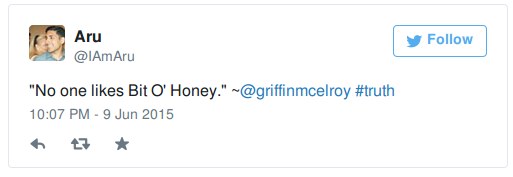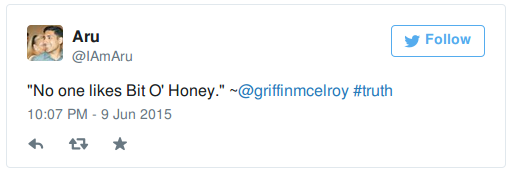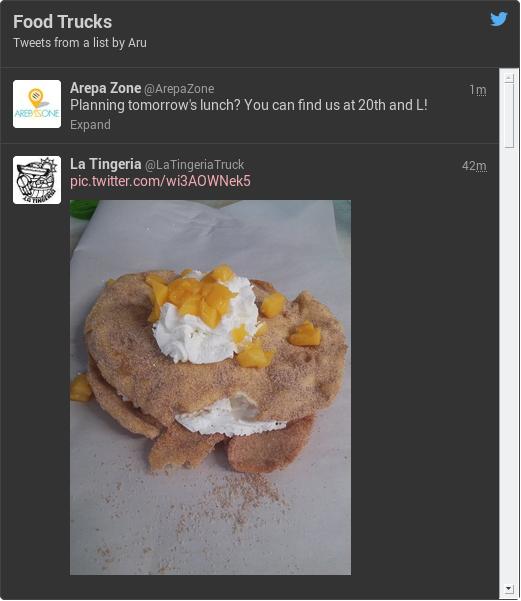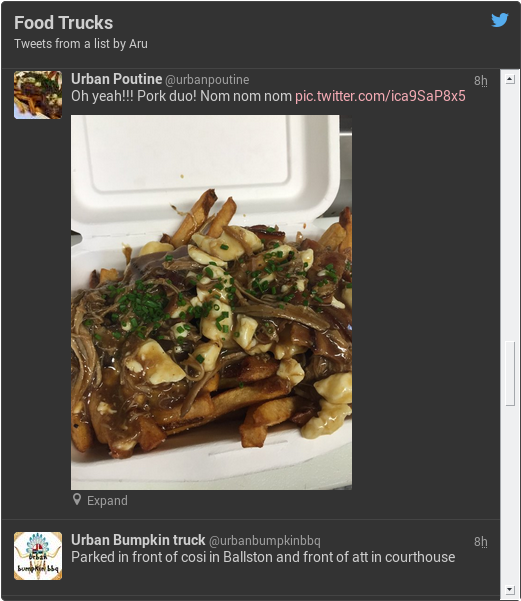Easily embed Twitter widgets into your Angular application! No more having to kludge together a Twitter script loader, or manage embed state on visibility change.
npm install --save ngtweet$ bower install ngtweetThen include ngtweet.js or ngtweet.min.js in your markup and add ngtweet to your application's dependencies. Your markup should look like this at the end:
<!doctype html>
<html ng-app="myApp">
<head>
<script src="//ajax.googleapis.com/ajax/libs/angularjs/1.4.1/angular.min.js"></script>
<script src="bower_modules/ngtweet/dist/ngtweet.min.js"></script>
<script type="text/javascript" charset="utf-8">
var myApp = angular.module('myApp', ['ngtweet']);
</script>
...
</head>
<body>
...
</body>
</html>There are two ways to embed a Twitter widget - with the source from Twitter (embedded), or via Tweet ID (linked).
Given the source for an embedded Tweet
<blockquote class="twitter-tweet" lang="en"><p lang="en" dir="ltr">"No one likes Bit O' Honey." ~<a href="https://twitter.com/griffinmcelroy">@griffinmcelroy</a> <a href="https://twitter.com/hashtag/truth?src=hash">#truth</a></p>— Aru (@IAmAru) <a href="https://twitter.com/IAmAru/status/608455483507245059">June 10, 2015</a></blockquote>
<script async src="//platform.twitter.com/widgets.js" charset="utf-8"></script>First, remove the <script> element from the markup. Then, simply wrap it in a <twitter-widget> tag:
<twitter-widget>
<blockquote class="twitter-tweet" lang="en"><p lang="en" dir="ltr">"No one likes Bit O' Honey." ~<a href="https://twitter.com/griffinmcelroy">@griffinmcelroy</a> <a href="https://twitter.com/hashtag/truth?src=hash">#truth</a></p>— Aru (@IAmAru) <a href="https://twitter.com/IAmAru/status/608455483507245059">June 10, 2015</a></blockquote>
</twitter-widget>Load your app, and you get:
Given a Tweet with ID '617749885933232128', simply add a <twitter-widget> tag to your markup with an attribute named twitter-widget-id specifying the Tweet ID.
<twitter-widget twitter-widget-id="'617749885933232128'">
</twitter-widget>This, combined with ngRepeat, can display collections of individual Tweets:
<!-- Note: Tweet IDs should be represented as strings in order to maintain precision -->
<div ng-repeat="tweetID in tweetIDs track by $index">
<twitter-widget twitter-widget-id="tweetID">
</twitter-widget>
</div>Given the source for an embedded timeline.
<a class="twitter-timeline" href="https://twitter.com/IAmAru/lists/food-trucks" data-widget-id="673710543212052480">Tweets from https://twitter.com/IAmAru/lists/food-trucks</a>
<script>!function(d,s,id){var js,fjs=d.getElementsByTagName(s)[0],p=/^http:/.test(d.location)?'http':'https';if(!d.getElementById(id)){js=d.createElement(s);js.id=id;js.src=p+"://platform.twitter.com/widgets.js";fjs.parentNode.insertBefore(js,fjs);}}(document,"script","twitter-wjs");</script>Remove the <script> element from the markup. Then wrap it in a <twitter-timeline> tag:
<twitter-timeline>
<a class="twitter-timeline" href="https://twitter.com/IAmAru/lists/food-trucks" data-widget-id="673710543212052480"> Tweets from https://twitter.com/IAmAru/lists/food-trucks</a>
</twitter-timeline>Load your app, and you get:
Given a timeline with ID '673710543212052480', simply add a <twitter-timeline> tag to your markup with an attribute named twitter-timeline-id specifying the Timeline ID.
<twitter-timeline twitter-timeline-id="'6673710543212052480'">
</twitter-timeline>Recently, Twitter updated how one goes about embedding a timeline - instead of generating an ID and linking to it, the parameters and type of timeline must be defined. To get the food truck timeline from above...
<twitter-timeline twitter-timeline-type='list'
twitter-timeline-owner-screen-name='"IAmAru"'
twitter-timeline-slug='"food-trucks"'>
</twitter-timeline>The first time the twitterWidget directive is encountered, ngTweet downloads Twitter's Widget script. If you would rather the script be downloaded at app startup, simply add the twitter-widget-initialize attribute to an element. For example,
<html ng-app="myapp">
<body twitter-widget-initialize>
</body>
</html>You can change the path to the widget.js file in case you want to host your own version:
angular.module("myApp", ['ngtweet'])
.value('twitterWidgetURL', '/PATH/TO/widgets.js'); //default https://platform.twitter.com/widgets.jsSince the widgets.js file is served over SSL by default, the twitterWidgetURL value can be modified to use the plain 'ol HTTP version.
Pull requests are welcomed! The existing code follows John Papa's wonderful Angular Style Guide. Run gulp build to generate the debug and minified JavaScript files, and then gulp serve to run the demo site to verify embeds work. Please include the compiled code within the dist/ directory with your PR.
This is very much a young library, so I'm open to suggestions as to what direction it should go. Currently eventing features and batch queries are slated for future development.



